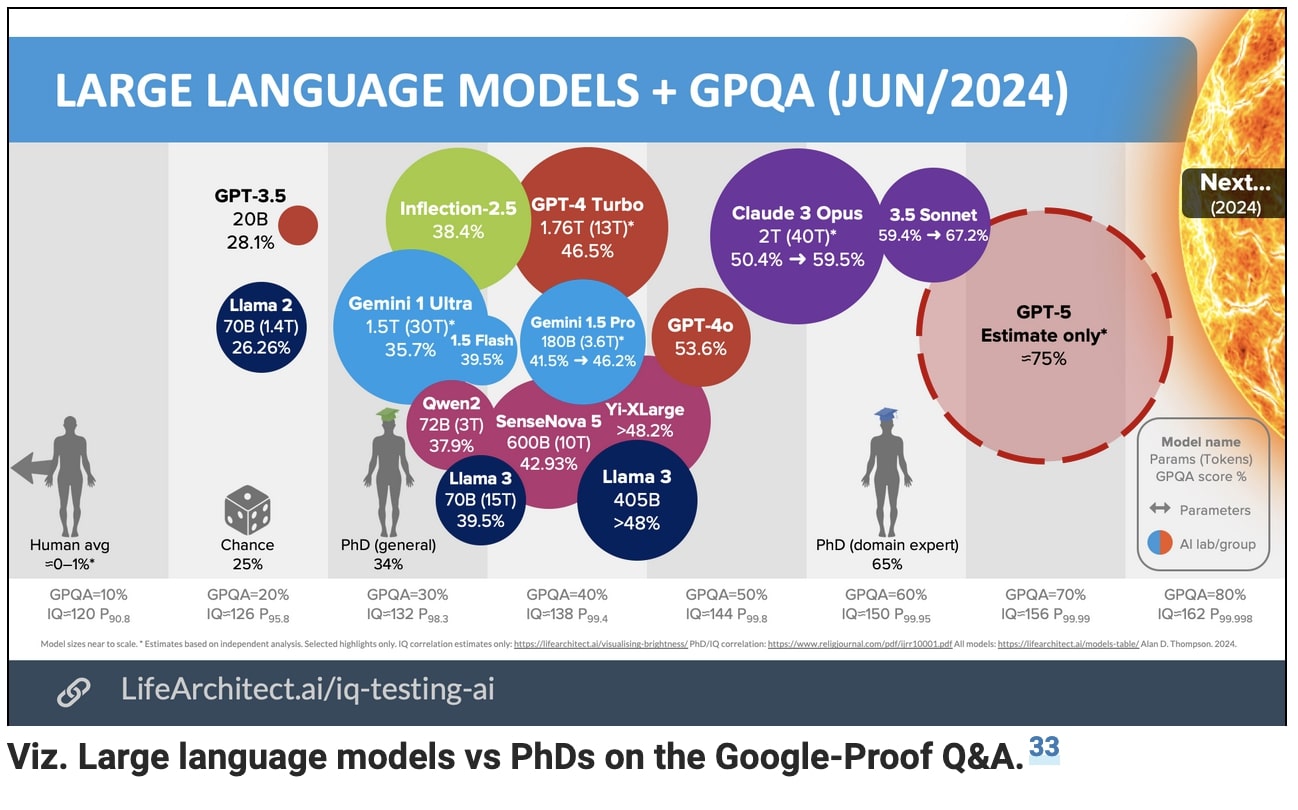Claude 3.5 Sonnet is the best performing AI model according to the advanced Google Proof Q&A test.

The concept of a “Google-proof” Q&A AI test and other benchmarks for evaluating higher-performing AI models are critical in measuring the capabilities and progress of artificial intelligence. These tests aim to assess AI’s ability to understand, reason, and generate human-like responses without relying on simple keyword matching or superficial data retrieval. Here’s an overview of what these tests entail and other benchmarks for evaluating high-performing AI:
Google-Proof Q&A AI Test
A “Google-proof” test is designed to evaluate an AI’s understanding and reasoning abilities rather than its ability to search and retrieve information. These tests focus on:
Complex Reasoning: Questions that require logical deduction, multi-step reasoning, and synthesis of information from various sources.
Common Sense: Assessing the AI’s ability to apply everyday knowledge and common sense reasoning to answer questions.
Inference: Requiring the AI to make inferences based on given data or context, rather than retrieving exact matches from a database.
Contextual Understanding: Evaluating how well the AI understands and maintains context across multiple sentences or interactions.
Example Questions:
“If Alice is taller than Bob and Bob is taller than Charlie, who is the shortest?”
“Why might someone carry an umbrella on a sunny day?”
Other Tests for Higher Performing AI
SQuAD (Stanford Question Answering Dataset):
Task: Reading comprehension.
Format: The model is given a passage and must answer questions based on that passage.
Evaluation: Measures exact match (EM) and F1 score (a harmonic mean of precision and recall).
GLUE (General Language Understanding Evaluation) Benchmark:
Task: A collection of various NLP tasks including sentiment analysis, sentence similarity, and natural language inference.
Evaluation: Provides a composite score based on performance across multiple tasks.
SuperGLUE:
Task: An improved and more challenging version of GLUE, with tasks that require more advanced reasoning and understanding.
Evaluation: Similar to GLUE but includes tasks like causal reasoning and multi-sentence inference.
Winograd Schema Challenge:
Task: Testing common sense reasoning.
Format: The model must resolve ambiguous pronouns in sentences where the correct answer requires understanding of commonsense reasoning.
Example: “The city councilmen refused the demonstrators a permit because they feared violence.” (Who feared violence?)
ARC (AI2 Reasoning Challenge):
Task: Science question answering.
Format: Multiple-choice questions from elementary and high school science exams.
Evaluation: Tests the model’s ability to reason and apply scientific knowledge.
TriviaQA:
Task: Open-domain question answering.
Format: The model is given trivia questions and must generate answers from a large corpus of documents.
Evaluation: Measures the accuracy of the generated answers.
HellaSwag:
Task: Commonsense reasoning.
Format: Given a context, the model must choose the most plausible continuation from several options.
Evaluation: Tests the model’s understanding of everyday events and commonsense logic.
Importance of Advanced AI Tests
Measuring Progress: These benchmarks help track the advancements in AI, pushing the boundaries of what AI systems can achieve.
Identifying Weaknesses: They highlight areas where AI systems need improvement, such as handling ambiguity, contextual reasoning, and applying commonsense knowledge.
Driving Innovation: The challenges posed by these tests stimulate research and innovation, leading to the development of more sophisticated AI models.
Advanced AI Tests
The “Google-proof” Q&A AI test and other advanced benchmarks are essential for evaluating the true capabilities of high-performing AI models. They ensure that AI systems are not only good at retrieving information but also excel at understanding, reasoning, and generating coherent, contextually appropriate responses. These tests drive the continuous improvement of AI technologies, making them more robust, versatile, and aligned with human-like understanding and intelligence.

Brian Wang is a Futurist Thought Leader and a popular Science blogger with 1 million readers per month. His blog Nextbigfuture.com is ranked #1 Science News Blog. It covers many disruptive technology and trends including Space, Robotics, Artificial Intelligence, Medicine, Anti-aging Biotechnology, and Nanotechnology.
Known for identifying cutting edge technologies, he is currently a Co-Founder of a startup and fundraiser for high potential early-stage companies. He is the Head of Research for Allocations for deep technology investments and an Angel Investor at Space Angels.
A frequent speaker at corporations, he has been a TEDx speaker, a Singularity University speaker and guest at numerous interviews for radio and podcasts. He is open to public speaking and advising engagements.




